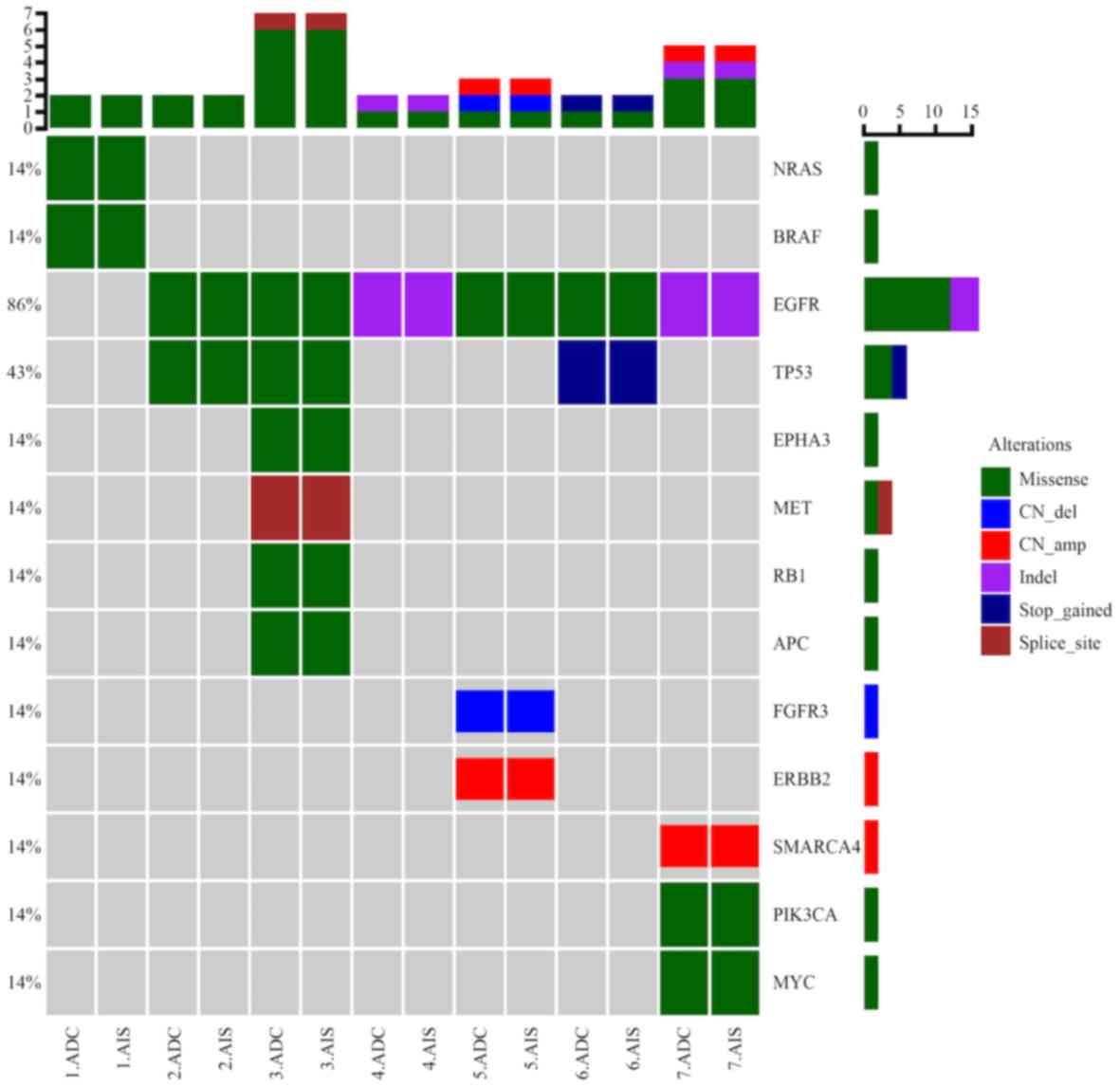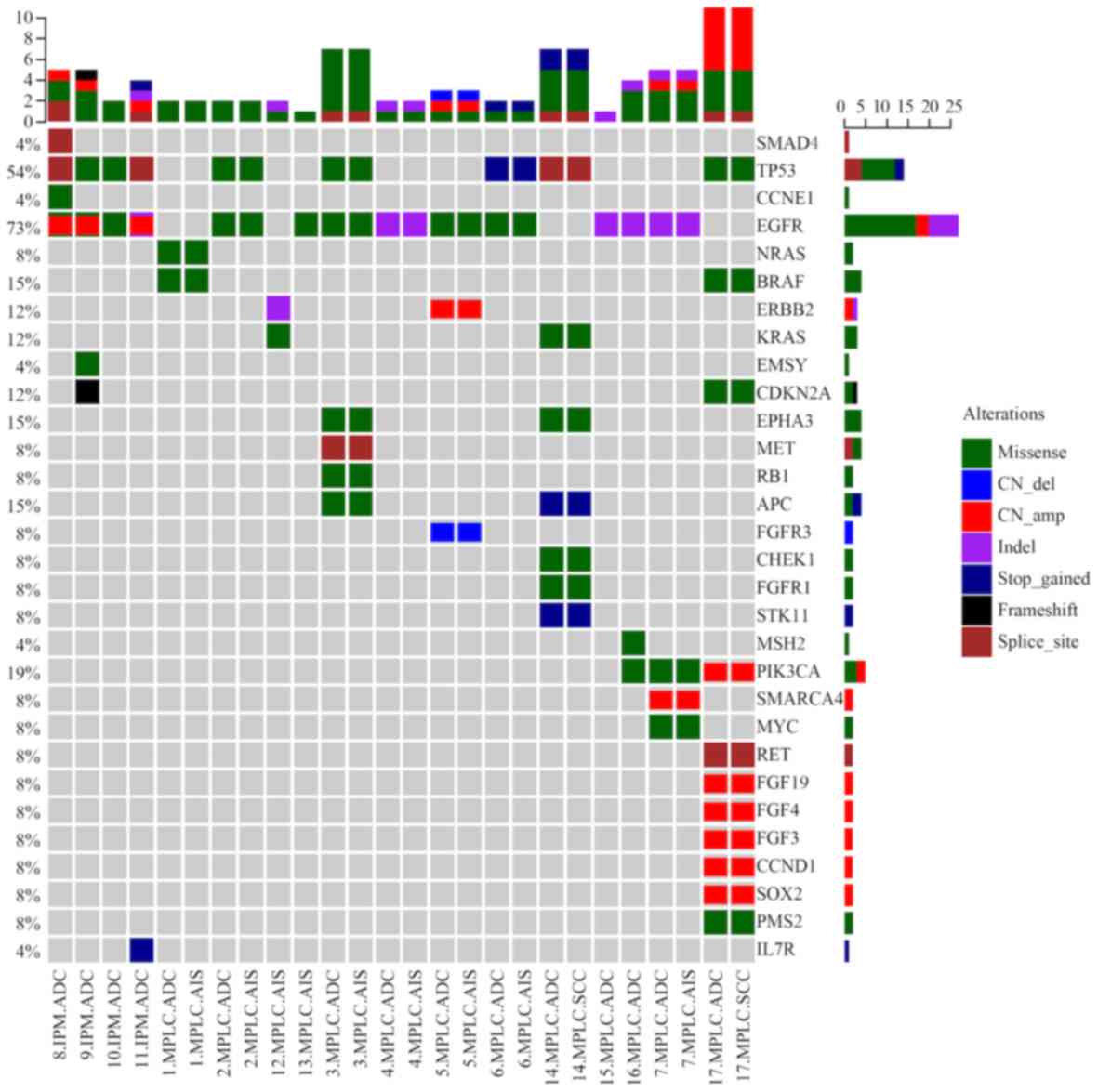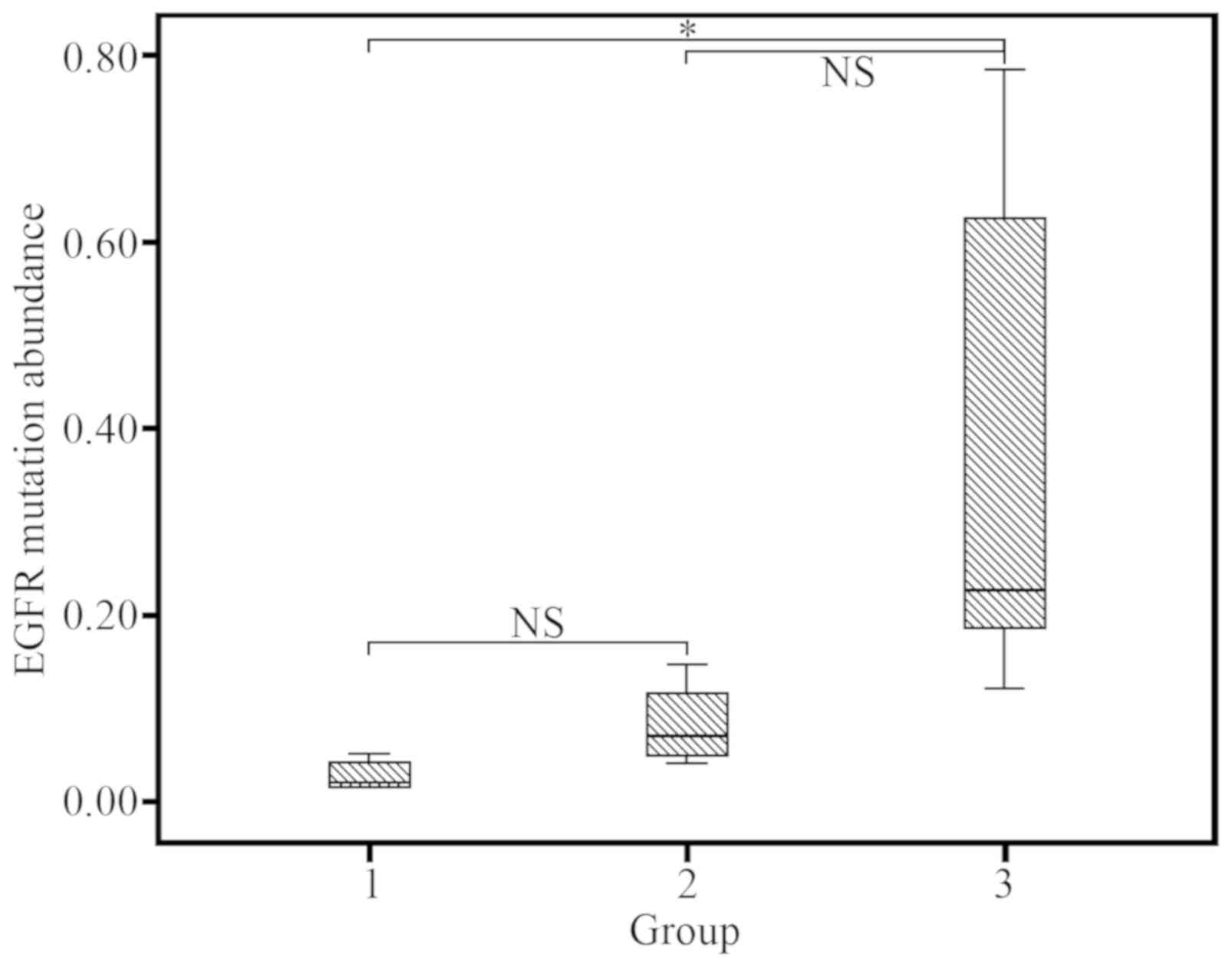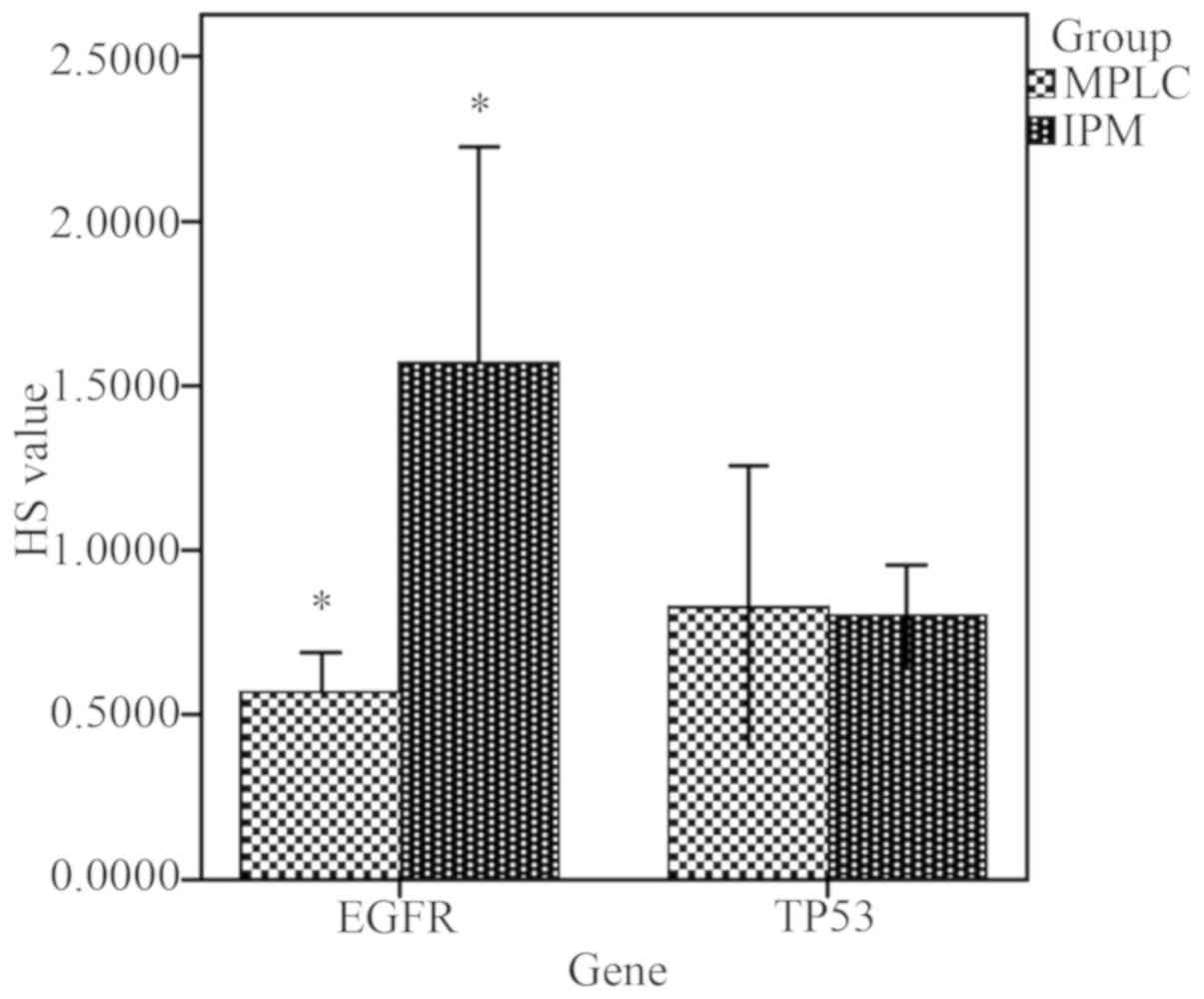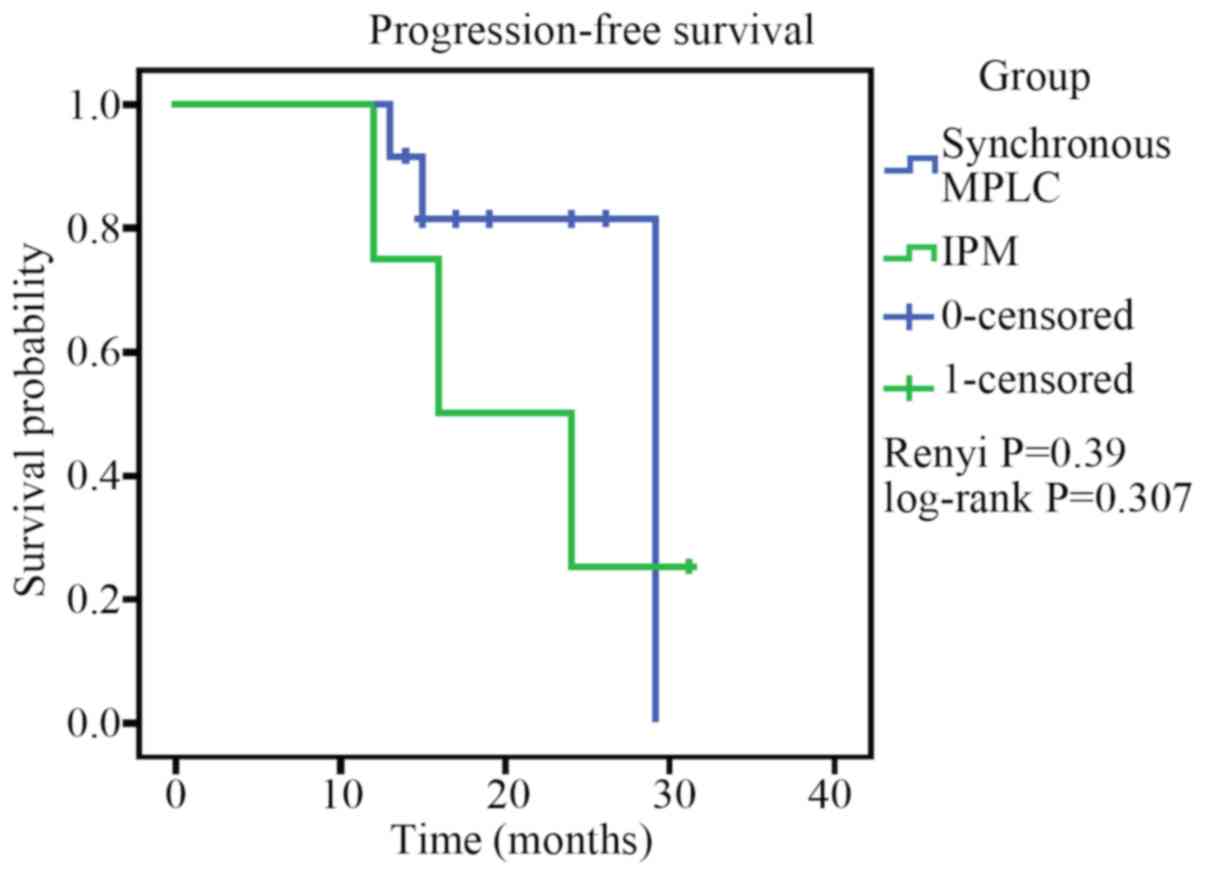|
1
|
Saab J, Zia H, Mathew S, Kluk M, Narula N
and Fernandes H: Utility of genomic analysis in differentiating
synchronous and metachronous lung adenocarcinomas from primary
adenocarcinomas with intrapulmonary metastasis. Transl Oncol.
10:442–449. 2017. View Article : Google Scholar : PubMed/NCBI
|
|
2
|
Nakata M, Sawada S, Yamashita M, Saeki H,
Kurita A, Takashima S and Tanemoto K: Surgical treatments for
multiple primary adenocarcinoma of the lung. Ann Thorac Surg.
78:1194–1199. 2004. View Article : Google Scholar : PubMed/NCBI
|
|
3
|
Pairolero PC, Williams DE, Bergstralh EJ,
Piehler JM, Bernatz PE and Payne WS: Postsurgical stage I
bronchogenic carcinoma: Morbid implications of recurrent disease.
Ann Thorac Surg. 38:331–338. 1984. View Article : Google Scholar : PubMed/NCBI
|
|
4
|
Martini N, Bains MS, Burt ME, Zakowski MF,
McCormack P, Rusch VW and Ginsberg RJ: Incidence of local
recurrence and second primary tumors in resected stage I lung
cancer. J Thorac Cardiovasc Surg. 109:120–129. 1995. View Article : Google Scholar : PubMed/NCBI
|
|
5
|
Aziz TM, Saad RA, Glasser J, Jilaihawi AN
and Prakash D: The management of second primary lung cancers. A
single centre experience in 15 years. Eur J Cardiothorac Surg.
21:527–533. 2002. View Article : Google Scholar : PubMed/NCBI
|
|
6
|
Schneider F and Dacic S: Histopathologic
and molecular approach to staging of multiple lung nodules. Transl
Lung Cancer Res. 6:540–549. 2017. View Article : Google Scholar : PubMed/NCBI
|
|
7
|
Detterbeck FC, Nicholson AG, Franklin WA,
Marom EM, Travis WD, Girard N, Arenberg DA, Bolejack V, Donington
JS, Mazzone PJ, et al: The IASLC lung cancer staging project:
Summary of proposals for revisions of the classification of lung
cancers with multiple pulmonary sites of involvement in the
forthcoming eighth edition of the TNM classification. J Thorac
Oncol. 11:639–650. 2016. View Article : Google Scholar : PubMed/NCBI
|
|
8
|
Amin MB, Edge SB, Greene FL, et al: AJCC
cancer staging manual. 8th. New York: Springer; 2017, View Article : Google Scholar
|
|
9
|
Donfrancesco E, Yvorel V, Casteillo F,
Stachowicz ML, Patoir A, Tiffet O, Péoc'h M and Forest F:
Histopathological and molecular study for synchronous lung
adenocarcinoma staging. Virchows Arch. 476:835–842. 2020.
View Article : Google Scholar : PubMed/NCBI
|
|
10
|
Patel SB, Kadi W, Walts AE, Marchevsky AM,
Pao A, Aguiluz A, Mudalige T, Liu Z, Deng N and Lopategui J:
Next-generation sequencing: A novel approach to distinguish
multifocal primary lung adenocarcinomas from intrapulmonary
metastases. J Mol Diagn. 19:870–880. 2017. View Article : Google Scholar : PubMed/NCBI
|
|
11
|
Schneider F, Derrick V, Davison JM,
Strollo D, Incharoen P and Dacic S: Morphological and molecular
approach to synchronous non-small cell lung carcinomas: Impact on
staging. Mod Pathol. 29:735–742. 2016. View Article : Google Scholar : PubMed/NCBI
|
|
12
|
Li W, Qiu T, Ling Y, Gao S and Ying J:
Subjecting appropriate lung adenocarcinoma samples to
next-generation sequencing-based molecular testing: Challenges and
possible solutions. Mol Oncol. 12:677–689. 2018. View Article : Google Scholar : PubMed/NCBI
|
|
13
|
Liu Y, Zhang J, Li L, Yin G, Zhang J,
Zheng S, Cheung H, Wu N, Lu N, Mao X, et al: Genomic heterogeneity
of multiple synchronous lung cancer. Nat Commun. 7:132002016.
View Article : Google Scholar : PubMed/NCBI
|
|
14
|
Xiao F, Zhang ZR, Wang XW, Liu DR, Guo YQ,
Shi B, Song ZY and Liang CY: Applying comprehensive histologic
assessment and genetic testing to synchronous multifocal lung
adenocarcinomas and further survival analysis. Chin Med J (Engl).
132:227–231. 2019. View Article : Google Scholar : PubMed/NCBI
|
|
15
|
Murphy SJ, Aubry MC, Harris FR, Halling
GC, Johnson SH, Terra S, Drucker TM, Asiedu MK, Kipp BR, Yi ES, et
al: Identification of independent primary tumors and intrapulmonary
metastases using DNA rearrangements in non-small-cell lung cancer.
J Clin Oncol. 32:4050–4058. 2014. View Article : Google Scholar : PubMed/NCBI
|
|
16
|
Robinson JT, Thorvaldsdóttir H, Wenger AM,
Zehir A and Mesirov JP: Variant review with the integrative
genomics viewer. Cancer Res. 77:e31–e34. 2017. View Article : Google Scholar : PubMed/NCBI
|
|
17
|
Li W, Qiu T, Guo L and Ying JM: Major
challenges related to tumor biological characteristics in accurate
mutation detection of colorectal cancer by next-generation
sequencing. Cancer Lett. 410:92–99. 2017. View Article : Google Scholar : PubMed/NCBI
|
|
18
|
Normanno N, Rachiglio AM, Lambiase M,
Martinelli E, Fenizia F, Esposito C, Roma C, Troiani T, Rizzi D,
Tatangelo F, et al: Heterogeneity of KRAS, NRAS, BRAF and PIK3CA
mutations in metastatic colorectal cancer and potential effects on
therapy in the CAPRI GOIM trial. Ann Oncol. 26:1710–1714. 2015.
View Article : Google Scholar : PubMed/NCBI
|
|
19
|
Cheng H, Lei BF, Peng PJ, Lin YJ and Wang
XJ: Histologic lung cancer subtype differentiates synchronous
multiple primary lung adenocarcinomas from intrapulmonary
metastases. J Surg Res. 211:215–222. 2017. View Article : Google Scholar : PubMed/NCBI
|
|
20
|
Hu X, Fujimoto J, Ying L, Fukuoka J,
Ashizawa K, Sun W, Reuben A, Chow CW, McGranahan N, Chen R, et al:
Multi-region exome sequencing reveals genomic evolution from
preneoplasia to lung adenocarcinoma. Nat Commun. 10:29782019.
View Article : Google Scholar : PubMed/NCBI
|
|
21
|
Nik-Zainal S, Van Loo P, Wedge DC,
Alexandrov LB, Greenman CD, Lau KW, Raine K, Jones D, Marshall J,
Ramakrishna M, et al: The life history of 21 breast cancers. Cell.
149:994–1007. 2012. View Article : Google Scholar : PubMed/NCBI
|
|
22
|
Shah SP, Morin RD, Khattra J, Prentice L,
Pugh T, Burleigh A, Delaney A, Gelmon K, Guliany R, Senz J, et al:
Mutational evolution in a lobular breast tumour profiled at single
nucleotide resolution. Nature. 461:809–813. 2009. View Article : Google Scholar : PubMed/NCBI
|
|
23
|
Gerlinger M, Rowan AJ, Horswell S, Math M,
Larkin J, Endesfelder D, Gronroos E, Martinez P, Matthews N,
Stewart A, et al: Intratumor heterogeneity and branched evolution
revealed by multiregion sequencing. N Engl J Med. 366:883–892.
2012. View Article : Google Scholar : PubMed/NCBI
|
|
24
|
Anderson K, Lutz C, van Delft FW, Bateman
CM, Guo Y, Colman SM, Kempski H, Moorman AV, Titley I, Swansbury J,
et al: Genetic variegation of clonal architecture and propagating
cells in leukaemia. Nature. 469:356–361. 2011. View Article : Google Scholar : PubMed/NCBI
|
|
25
|
Thunnissen E, Beasley MB, Borczuk AC,
Brambilla E, Chirieac LR, Dacic S, Flieder D, Gazdar A, Geisinger
K, Hasleton P, et al: Reproducibility of histopathological subtypes
and invasion in pulmonary adenocarcinoma. An international
interobserver study. Mod Pathol. 25:1574–1583. 2012. View Article : Google Scholar : PubMed/NCBI
|
|
26
|
Girard N, Deshpande C, Lau C, Finley D,
Rusch V, Pao W and Travis WD: Comprehensive histologic assessment
helps to differentiate multiple lung primary nonsmall cell
carcinomas from metastases. Am J Surg Pathol. 33:1752–1764. 2009.
View Article : Google Scholar : PubMed/NCBI
|
|
27
|
Girard N, Ostrovnaya I, Lau C, Park B,
Ladanyi M, Finley D, Deshpande C, Rusch V, Orlow I, Travis WD, et
al: Genomic and mutational profiling to assess clonal relationships
between multiple non-small cell lung cancers. Clin Cancer Res.
15:5184–5190. 2009. View Article : Google Scholar : PubMed/NCBI
|
|
28
|
La Fleur L, Falk-Sörqvist E, Smeds P,
Berglund A, Sundström M, Mattsson JS, Brandén E, Koyi H, Isaksson
J, Brunnström H, et al: Mutation patterns in a population-based
non-small cell lung cancer cohort and prognostic impact of
concomitant mutations in KRAS and TP53 or STK11. Lung Cancer.
130:50–58. 2019. View Article : Google Scholar : PubMed/NCBI
|
|
29
|
Jakobsen JN, Santoni-Rugiu E, Grauslund M,
Melchior L and Sørensen JB: Concomitant driver mutations in
advanced EGFR-mutated non-small-cell lung cancer and their impact
on erlotinib treatment. Oncotarget. 40:26195–26208. 2018.
View Article : Google Scholar
|
|
30
|
Skov BG, Høgdall E, Clementsen P, Krasnik
M, Larsen KR, Sørensen JB, Skov T and Mellemgaard A: The prevalence
of EGFR mutations in non-small cell lung cancer in an unselected
Caucasian population. APMIS. 123:108–115. 2015. View Article : Google Scholar : PubMed/NCBI
|
|
31
|
Shi Y, Li J, Zhang S, Wang M, Yang S, Li
N, Wu G, Liu W, Liao G, Cai K, et al: Molecular epidemiology of
EGFR mutations in asian patients with advanced non-small-cell lung
cancer of adenocarcinoma histology-mainland China subset analysis
of the PIONEER study. PLoS One. 10:e01435152015. View Article : Google Scholar : PubMed/NCBI
|
|
32
|
Shi Y, Au JS, Thongprasert S, Srinivasan
S, Tsai CM, Khoa MT, Heeroma K, Itoh Y, Cornelio G and Yang PC: A
Prospective, molecular epidemiology study of EGFR mutations in
asian patients with advanced non-small-cell lung cancer of
adenocarcinoma histology (PIONEER). J Thorac Oncol. 9:154–162.
2014. View Article : Google Scholar : PubMed/NCBI
|
|
33
|
Guibert N, Barlesi F, Descourt R, Lena H,
Besse B, Beau-Faller M, Mosser J, Pichon E, Merlio JP, Ouafik L, et
al: Characteristics and outcomes of patients with lung cancer
harboring multiple molecular alterations: Results from the IFCT
study biomarkers France. J Thorac Oncol. 12:963–973. 2017.
View Article : Google Scholar : PubMed/NCBI
|
|
34
|
Tetsu O, Hangauer MJ, Phuchareon J, Eisele
DW and McCormick F: Drug resistance to EGFR inhibitors in lung
cancer. Chemotherapy. 61:223–235. 2016. View Article : Google Scholar : PubMed/NCBI
|
|
35
|
Eng J, Woo KM, Sima CS, Plodkowski A,
Hellmann MD, Chaft JE, Kris MG, Arcila ME, Ladanyi M and Drilon A:
Impact of concurrent PIK3CA mutations on response to EGFR tyrosine
kinase inhibition in EGFR-Mutant lung cancers and on prognosis in
oncogene-driven lung adenocarcinomas. J Thorac Oncol. 10:1713–1719.
2015. View Article : Google Scholar : PubMed/NCBI
|
|
36
|
Ulivi P, Chiadini E, Dazzi C, Dubini A,
Costantini M, Medri L, Puccetti M, Capelli L, Calistri D, Verlicchi
A, et al: Nonsquamous, non-small-cell lung cancer patients who
carry a double mutation of EGFR, EML4-ALK or KRAS: Frequency,
clinical-pathological characteristics, and response to therapy.
Clin Lung Cancer. 17:384–390. 2016. View Article : Google Scholar : PubMed/NCBI
|
|
37
|
Riely GJ, Kris MG, Rosenbaum D, Marks J,
Li A, Chitale DA, Nafa K, Riedel ER, Hsu M, Pao W, Miller VA and
Ladanyi M: Frequency and distinctive spectrum of KRAS mutations in
never smokers with lung adenocarcinoma. Clin Cancer Res.
14:5731–5734. 2008. View Article : Google Scholar : PubMed/NCBI
|
|
38
|
McIntyre A and Ganti AK: Lung cancer-A
global perspective. J Surg Oncol. 115:550–554. 2017. View Article : Google Scholar : PubMed/NCBI
|
|
39
|
Jiang L, Huang J, Morehouse C, Zhu W,
Korolevich S, Sui D, Ge X, Lehmann K, Liu Z, Kiefer C, et al: Low
frequency KRAS mutations in colorectal cancer patients and the
presence of multiple mutations in oncogenic drivers in non-small
cell lung cancer patients. Cancer Genet. 206:330–339. 2013.
View Article : Google Scholar : PubMed/NCBI
|















